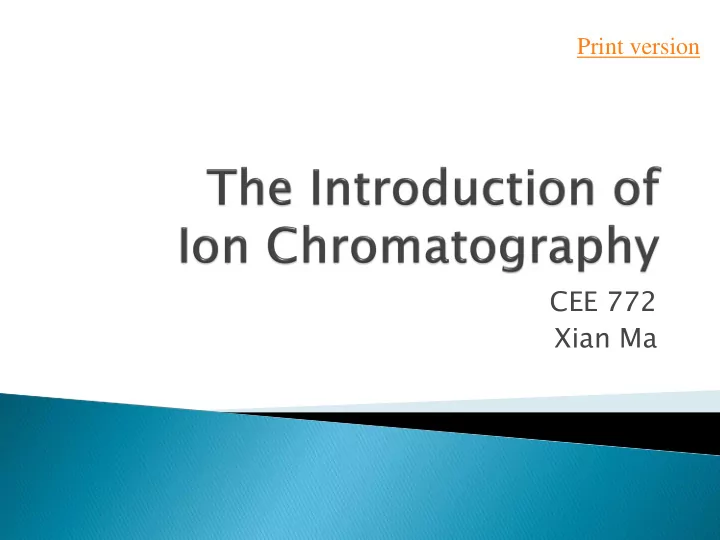

Print version CEE 772 Xian Ma
1, Introduction What is IC? What are their names of each part? 2, Principle How does anion or cation be determined? 3, Process How does IC work? 4, Application Where can we use IC? 5, Operation Steps How should I operate this machine properly?
ion chromatography is a process that allows the separation of ions and polar molecules based on their affinity to the ion exchanger. It can be used for almost any kind of charged molecule including large proteins, small nucleotides and amino acids. The solution to be injected is usually called a sam sample, and the individually separated components are called an anal alyte ytes. The media that carries ions are called elu elutes.
Ion-exchange chromatography retains analyte molecules on the column based on coulombic (ionic) interactions. The stationary phase surface displays ionic functional groups (R-X) that interact with analyte ions of opposite charge. The ionic compound consisting of the cationic species M+ and the anionic species B- can be retained by the stationary phase.
Cation exchange chromatography retains positively charged cations because the stationary phase displays a negatively charged functional group: Anion exchange chromatography retains anions using positively charged functional group: Note that the ion strength of either C+ or A- in the mobile phase can be adjusted to shift the equilibrium position and thus retention time. The ion chromatogram shows a typical chromatogram obtained with an anion exchange column.
A sample is introduced, either manually or with an autosam sampler er, into a sample loop of known volume. A buffered aqueous solution known as the mobile phase carries the sample from the loop onto a column that contains some form of stationary phase material. This is typically a resin or gel matrix consisting of agarose or cellulose beads with covalently bonded charged functional groups. The target analytes(anions or cations) are retained on the stationary phase but can be eluted by increasing the concentration of a similarly charged species that will displace the analyte ions from the stationary phase.
For example, in cation exchange chromatography, the positively charged analyte could be displaced by the addition of positively charged sodium ions. The analytes of interest must then be detected by some means, typically by conduct ctivity or ce . UV/Visi Visible le l light a absorbance
Clin linic ical l utility tility Used in measurement of porphyrin & water purification. Industr ustrial Applic pplication tions Allows for quantitative testing of electrolyte and proprietary additives of electroplating baths. It is an advancement of qualitative cell testing or less accurate UV testing. Ions, catalysts, brighteners and accelerators can be measured.
1, Preparation of elutes. 2, Dilute the sample into a properly concentration. 3, Preparation of standard solutions. (0.2 mg/L to 10 mg/L) 4, Place sample and solutions on the autosampler. 5, Run the program
1, Eith, Claudia, Kolb Maximilian, and Seubert Andreas. "Introduction." Practical Ion Chromatography An Introduction. Ed. Viehweger Kai. Herisau: Metrohm, 2002. 160. 2, Sakash, J.B.; Kantrowitz, E.R. (2000). "The contribution of individual interchain interactions to the stabilization of the T and R states of Escherichia coli aspartate transcarbamoylase.". J Biol Chem 275 (37): 287017. doi:10.1074/jbc.M005079200. PMID 10875936. 3, Fairhead, M. (2013). "Plug-and-Play Pairing via Defined Divalent Streptavidins.". J Mol Biol 426 (1): 199– 214. doi:10.1016/j.jmb.2013.09.016. PMID 24056174. 4, b Robert E. Smith (31 December 1987). Ion Chromatography Applications. CRC Press. ISBN 978-0- 8493-4967-6.
To next lecture
Recommend
More recommend